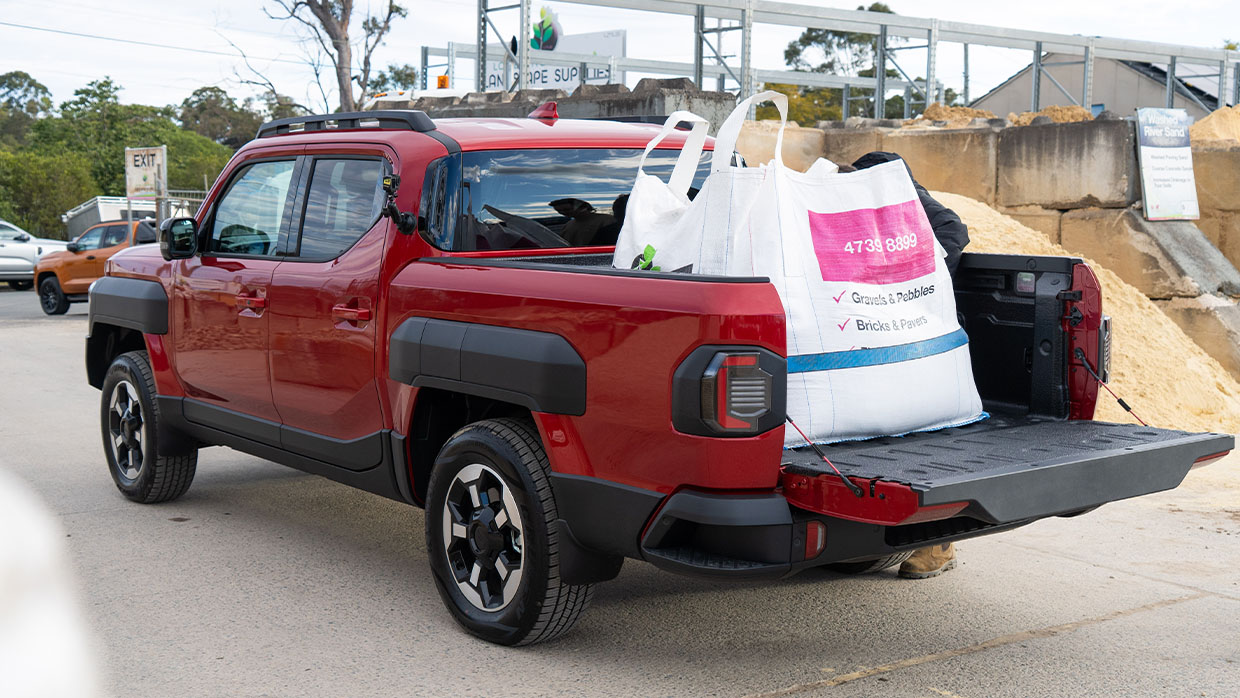-
Car Reviews
- All reviews
- Midsize SUVs
- Small cars
- Utes
- Small SUVs
- Large SUVs
- Large cars
- Sports SUVs
- Sports cars
- Vans
Latest reviews
- Car News
-
Car Comparisons
Latest comparisons
- Chasing Deals
You’ve seen the reviews of the top-end Tasman X-Pro, but how does Kia’s first ute stack up as a more affordable workhorse?
The Kia Tasman has landed in the Australian market on the strength of celebrity endorsements, Kia’s reputation for local chassis tuning and, well, very noticeable styling.
Kia says it is carrying several thousand orders, most of which — as well as most Tasman reviews — relate to the top-end, high-riding X-Pro version.
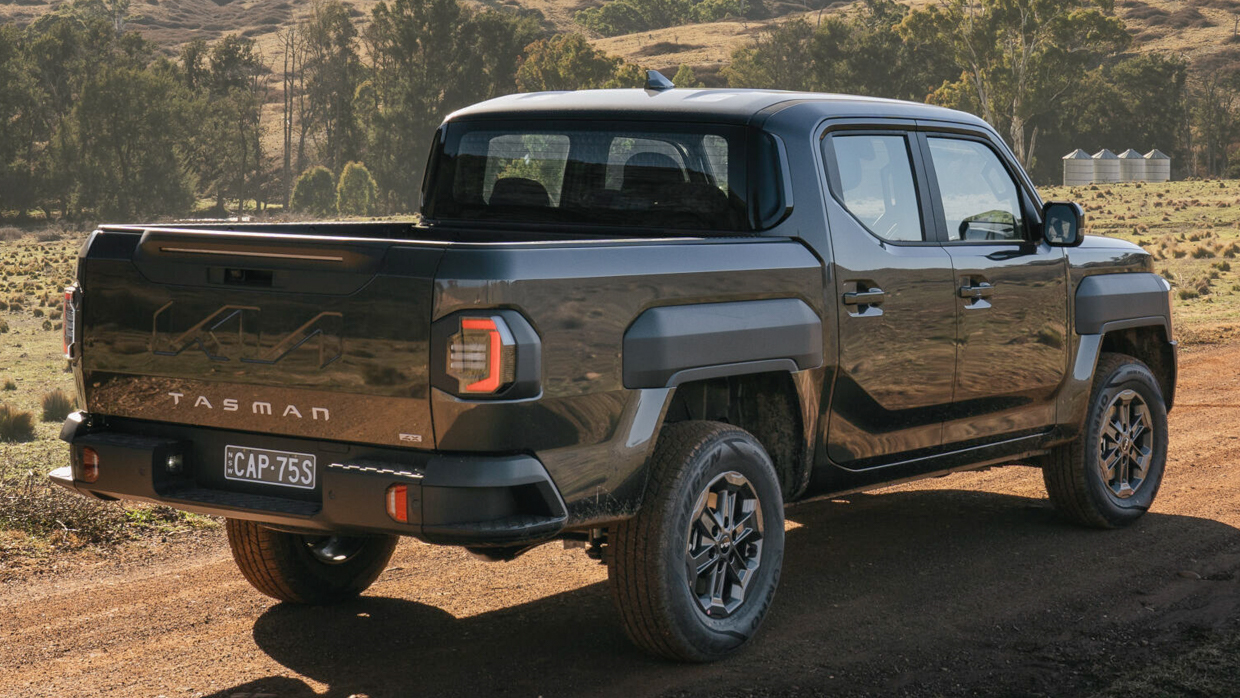
Typically, when a new vehicle launches, the fanciest trim grades sell out first as early adopters jump on the bandwagon. But for the Tasman, the fleet, tradie and work-focussed versions will make up at least half of this ute’s sales moving forward.
That’s why we’re concentrating on the Kia Tasman S, SX and SX+ grades in this review. While we’ll see plenty of X-Line and X-Pro versions getting around on Aussie roads, these hard-working Tasman trims are the foundations supporting the project.
With the Tasman having been developed extensively in Australia, and with local sales projected to account for one-third of global demand, Kia says this ute has been designed for Aussie tastes in ride, interior, and handling.
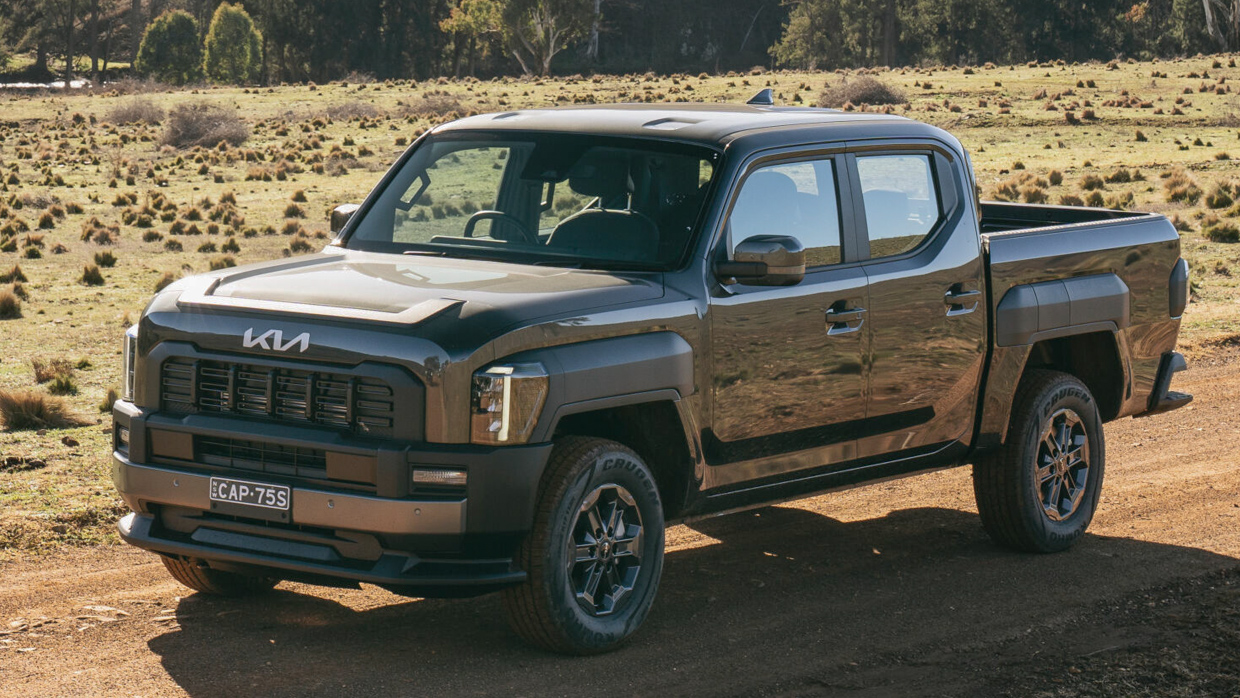
For the versions of the Tasman that will be spending day and night on the road, does that make a difference compared to the Ford Ranger, Toyota HiLux, Isuzu D-Max, Mitsubishi Triton and the other utes?
And, in the case of the SX and SX+ versions of the Tasman, does it still make sense to buy the Kia over a Chinese ute with more luxury — and maybe even a hybrid system that can power tools from its battery?
You’ll spend in the seventies to get into an X-series Tasman but the S, SX and SX+ versions are much cheaper, priced between $38,010 and $62,390 before on-road costs depending on trim and body style. All pack at least a tonne of payload in standard form, too.
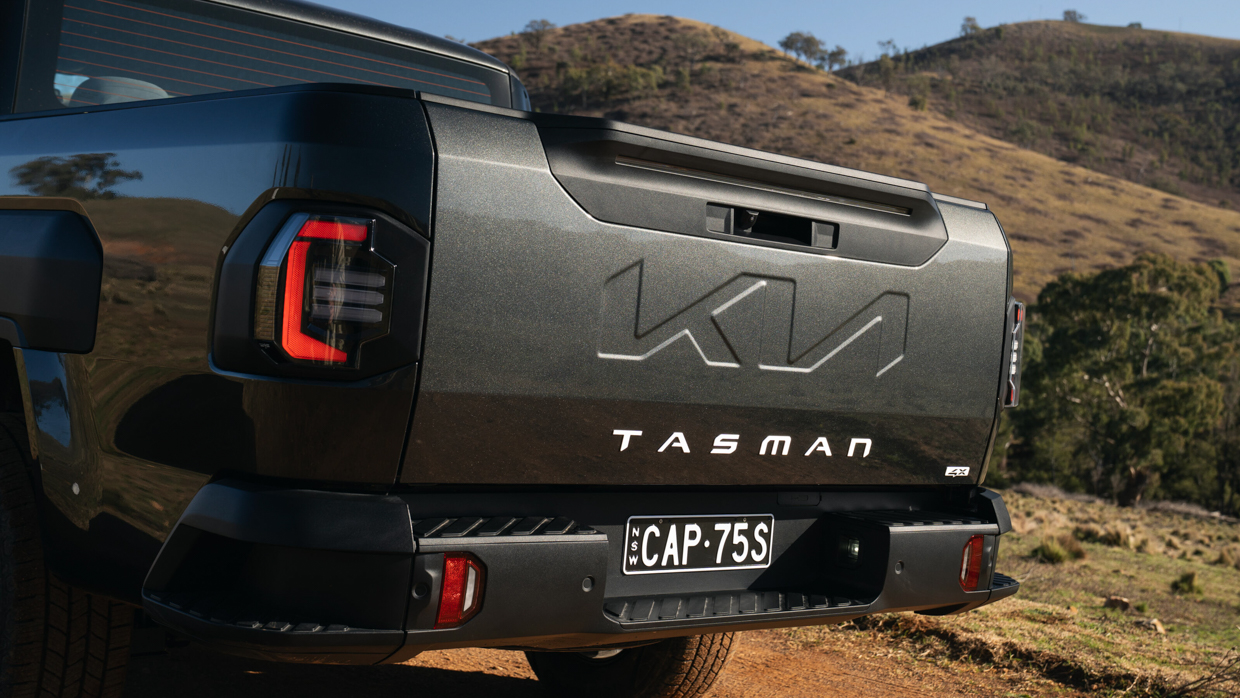
Unlike the X-series, the lower grades of Tasman are available in single cab-chassis and double cab-chassis versions along with tubbed dual-cabs. Four-door versions are available now, and the singles land before the end of 2025.
All Tasmans (no matter the body or driven wheels) use a 2.2-litre single turbo diesel four-cylinder engine making 154kW/440Nm and an eight-speed automatic transmission.
Only the Tasman S can be specified with 4×2 (rear-wheel drive), with 4WD attracting a considerable premium of nearly $7000 across the body styles.

Beyond trim grades, the Tasman range is also split into body style. The table below sets out the list and driveaway pricing (where offered) for the grades that are subject to this review:
| Grade | Body style | List price | Driveaway offer |
|---|---|---|---|
| S 4×2 | Single cab-chassis | $38,010 | – |
| S 4×2 | Double cab pick-up | $42,990 | $46,490 |
| S 4×4 | Single cab-chassis | $45,010 | – |
| S 4×4 | Double cab-chassis | $48,240 | – |
| S 4×4 | Double cab pick-up | $49,990 | $53,890 |
| SX 4×4 | Single cab-chassis | $49,520 | – |
| SX 4×4 | Double cab-chassis | $52,740 | – |
| SX 4×4 | Double cab pick-up | $54,490 | $58,490 |
| SX+ 4×4 | Double cab pick-up | $62,390 | $66,490 |
| X-Line 4×4 | Double cab pick-up | $67,990 | $70,990 |
| X-Pro 4×4 | Double cab pick-up | $74,990 | $77,990 |
Taking the second-tier Tasman SX 4×4 double cab-chassis as a point of comparison, the Kia sits in the thick of the segment nestled between the Triton and HiLux in terms of purchase price — though the Tasman is considerably dearer than the Chinese GWM Cannon.
| Rival | Body style | List price | Driveaway offer |
|---|---|---|---|
| GWM Cannon Lux 4×4 | Double cab-chassis | $42,290 | $42,290 |
| Mitsubishi Triton GLX+ 4×4 | Double cab-chassis | $51,990 | $52,490 |
| Kia Tasman SX 4×4 | Double cab-chassis | $52,740 | – |
| Toyota HiLux SR 4×4 | Double cab-chassis | $53,105 | – |
| Isuzu D-Max LS-M 4×4 | Double cab-chassis | $54,300 | – |
| Mazda BT-50 XT 4×4 | Double cab-chassis | $54,620 | – |
| Ford Ranger XLS 4×4 (2.0TT) | Double cab-chassis | $57,880 | – |
Tasman S buyers score a reasonably well-equipped ute, particularly inside, where the cheapest Tasmans score comfortable cloth seating with manual adjustment, dual 12.3-inch displays with wireless Apple CarPlay and wireless Android Auto, leather-look steering wheel and gear shifter cover, and dual-zone climate control.
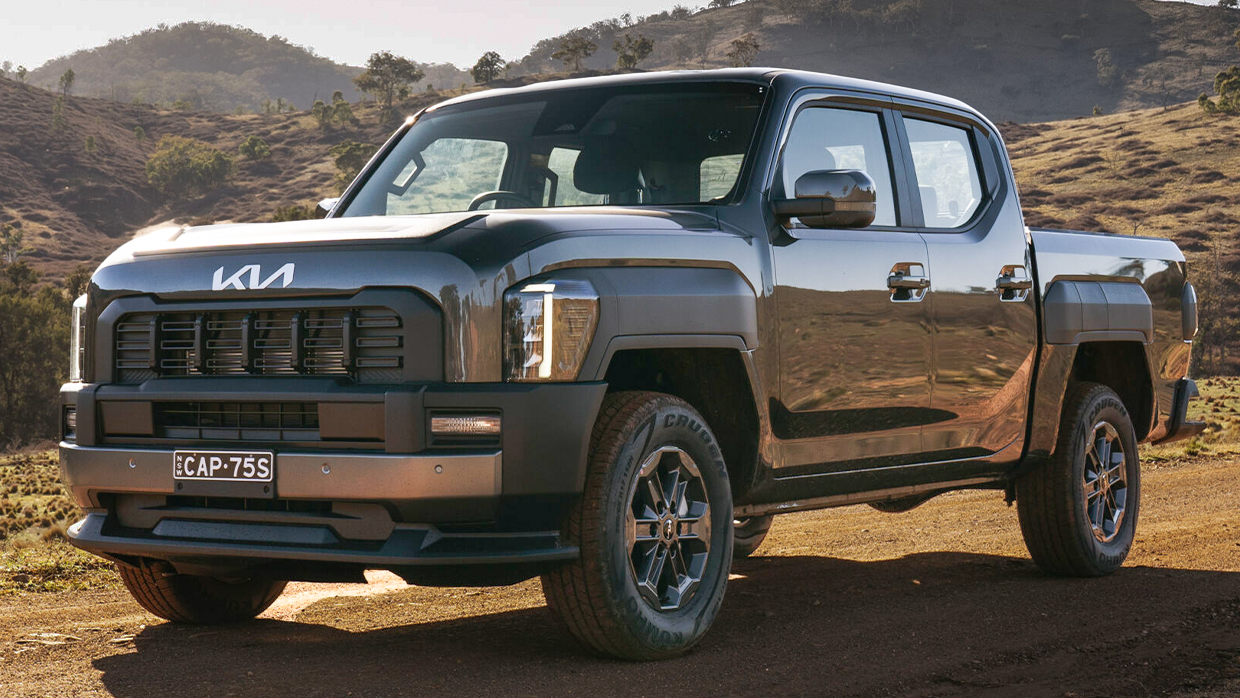
The S is also equipped with LED headlights, adaptive cruise control, lane keep assist, tyre pressure monitoring, tip-up rear seat storage (double-cab versions) and the Kia Connect companion smartphone app for conveniences like remote unlocking and air con start.
Step up to the SX for another ~$4500 and the external appearance gets a lift, with the S’s black 17-inch steel wheels replaced by grey-painted alloys of the same size.
The colour palette also expands to include Tan Beige and Denim Blue (S is only available in Clear White, Steel Grey, Interstellar Grey, and Aurora Black Pearl). SX also adds integrated satellite navigation, along with Highway Driving Assistant 2 (HDA2) to strengthen the Tasman’s ability to drive semi-autonomously for longer stretches.

From there, it’s a big $8000 step up into the SX+ grade (double cab pick-up only), which substantially ups the plushness to include cloth/leatherette seating, rear air vents, a wireless device charger, rear seatback pockets, two 240-volt power outlets (one in the tray, one in the back seat), a tub liner, and 18-inch machined alloys.
All Tasman grades come standard with a greater-than-one-tonne payload (1013-1124kg), bringing with it a 3250kg gross vehicle mass…and a relatively modest 6200kg gross combination mass.
These ratings suit trailers up to 3000kg without issue but towing the full rated 3500kg braked towing limit with a 350kg tow bar download eats significantly into payload.
Pictured: 2025 Kia Tasman X-Line carrying a 600kg payload
For operators who occasionally venture off-road, or who want a ute with greater kerb appeal, Kia offers the Tasman X-Line ($70,990 driveaway) and($77,990 driveaway) X-Pro grades at higher cost.
Both feature more rugged styling and greater ground clearance but as a result, they sacrifice their five-star ANCAP rating.
Every Tasman has a full-size matching spare wheel.
The Tasman, which sources its four-cylinder diesel from the Kia Sorento SUV and its eight-speed auto from the defunct Stinger sports sedan, has copped flak for lacking a V6 or hybrid engine — but those complaints are much more relevant in the posh models.
Here in the S/SX/SX+ grades, the 154kW/440Nm’s on-paper outputs are considerably less offensive and it’s actually a strong performer, both in isolation and back-to-back against rivals that typically offer 10-15 percent more peak torque.
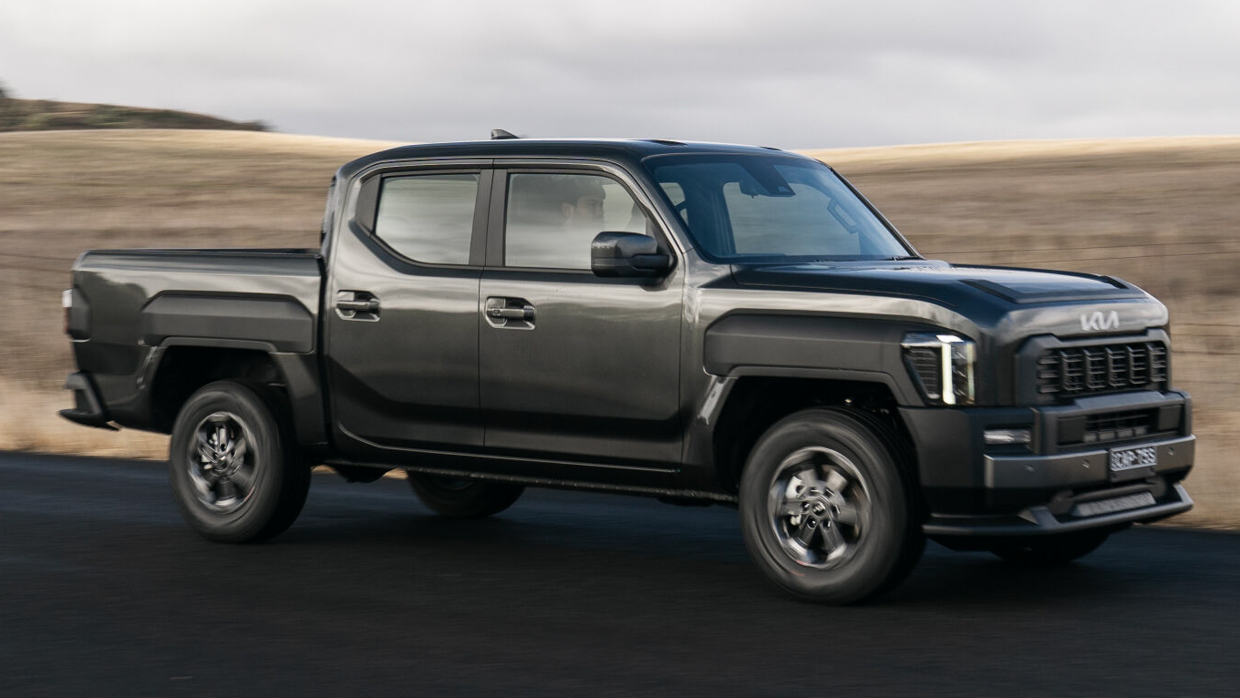
Kia talks up the fact that the Tasman’s 2.2-litre maintains 400Nm further into the rev range than HiLux or a four-cylinder Ranger, and that flexibility does translate to solid performance on-road even if the Kia does not lead the class for outright punch.
The eight-speed torque converter automatic has reconfigured shift logic to suit the Tasman and it does its best to make the most of what the ‘Smartstream’ engine offers.
The gearbox shifts frequently but intuitively, busily keeping the Tasman in its torque band.
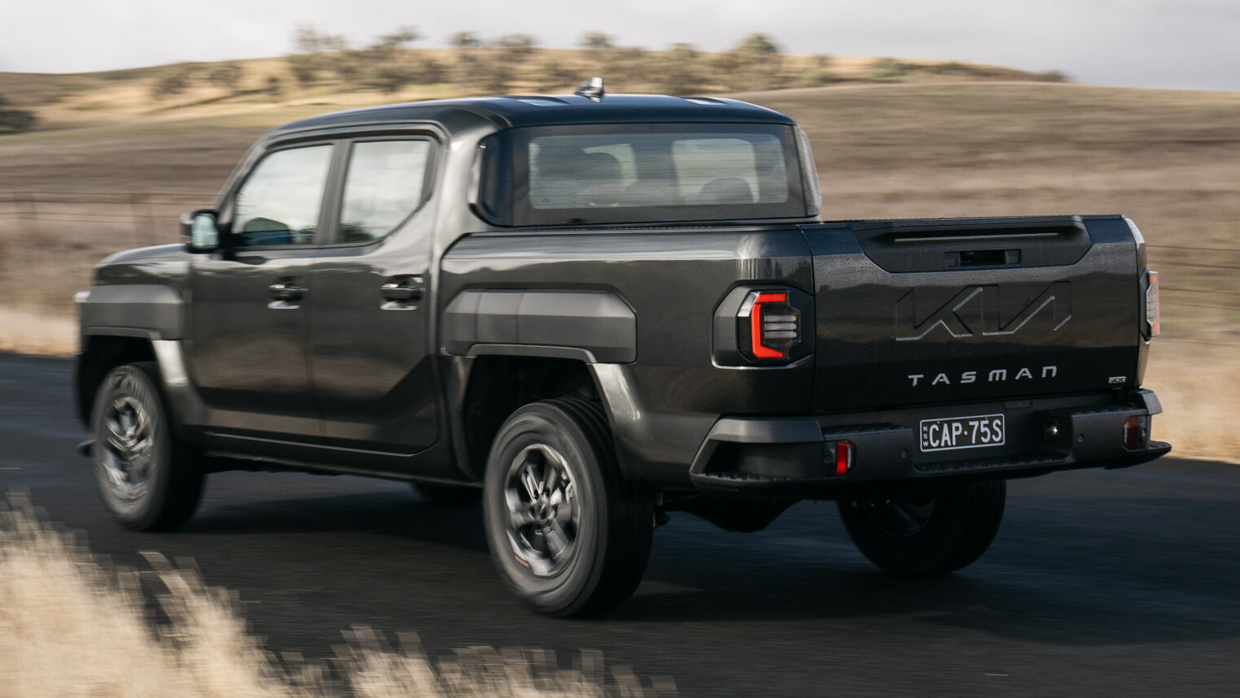
With a clean-sheet ladder frame and bespoke suspension tune developed both in Australia and with considerable input from Kia Australia experts, the Tasman drives like a ute built to high standards.
Local engineers worked extensively on steering feel and ride quality, particularly for unladen compliance, and the result is a ute that is comfortable for tradies and fleet operators that will spend plenty of time behind the wheel on-road.
A stiffer initial tune developed in Korea during COVID was later softened through Australian benchmarking of rivals, with significant upgrades made to the Kia’s rear leaf-sprung suspension before launch.
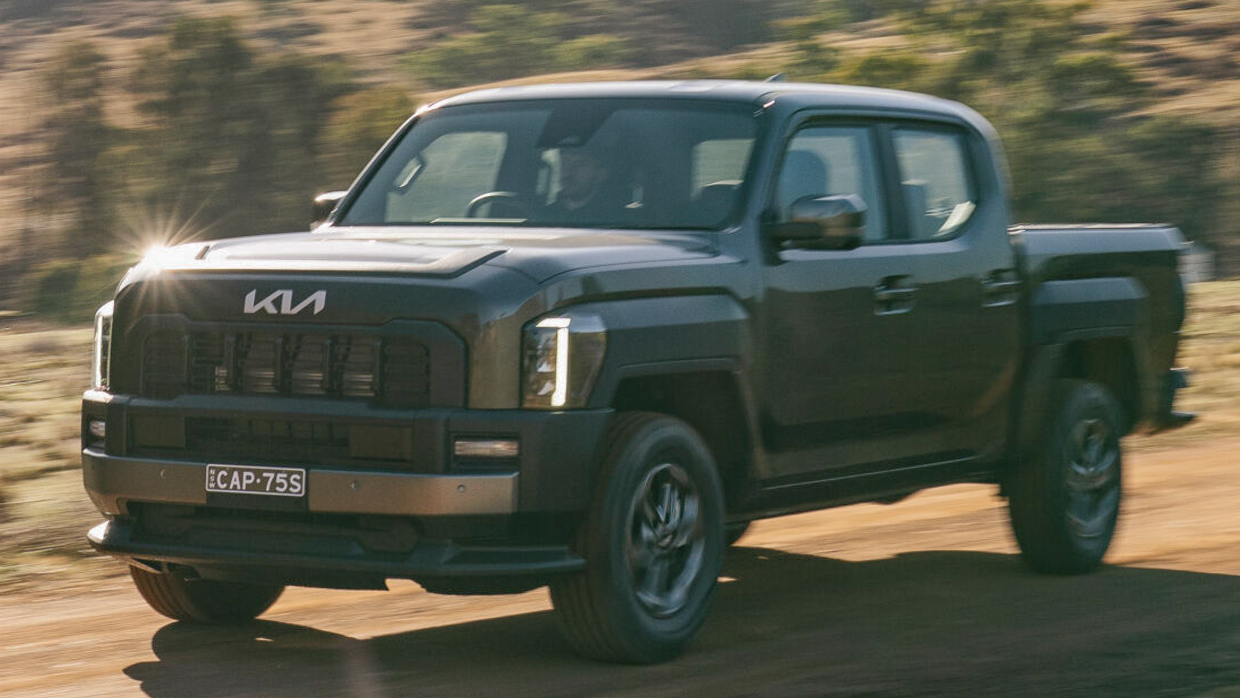
All grades of Tasman use a traditional double wishbone front, and leaf-sprung rear, suspension layout, but Kia’s switch from single-rate to sophisticated triple-rate leafs (plus ZF Sachs frequency-selective dampers normally reserved for premium SUVs) helps the Tasman deliver a settled and composed ride, particularly at speed.
In urban settings the ride is firmer but not jarring, and bump absorption is impressive. Hydraulic rebound stops take the sting out of large suspension extensions such as crests and deep potholes, helping the Tasman feel more composed than a D-Max or a Navara.
Steering is mid-weighted and accurate, with Kia’s tuning of the electric rack producing an SUV-like feel. While road feedback is somewhat limited due to the rubber mounting of the steering rack (intended to isolate vibrations), the Tasman turns in crisply and remains poised in the corners.

The Kia is closer to Ranger and Amarok in road manners than might have been expected for a newcomer.
Off-road, the Tasman S/SX/SX+ are limited by their low front-end design which benefits pedestrian safety but cuts approach angle to just 20 degrees — well down on the X-series versions (as high as 32deg).
Departure and breakover angles (25deg and 23deg) are par for the course and 800mm wading depth remains consistent across the range.
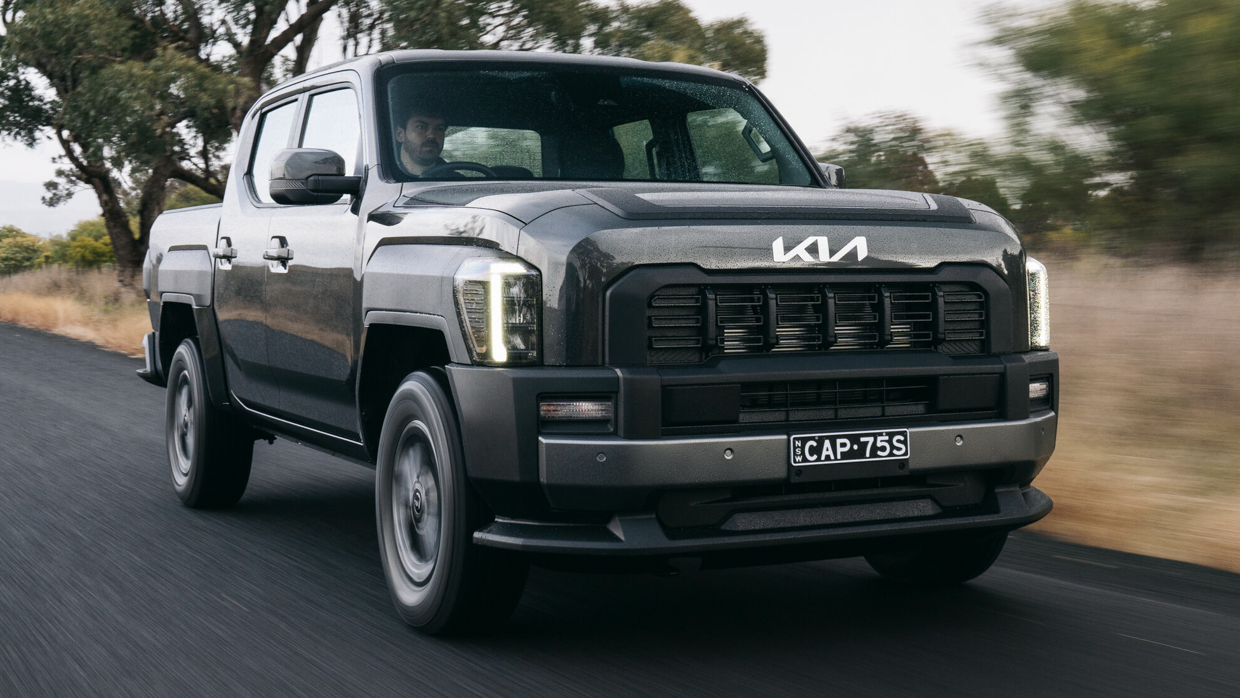
Lower-end Tasmans have a ‘passively locking’ rear differential that uses a clutch-based system to lock up when a difference of greater than 125rpm in rear wheel speeds is detected to give a locking effect.
More advanced off-road tech and hardware, such as a selectable electronically locking rear diff or terrain mode displays, are reserved for the top-tier X-Pro.
An integrated trailer brake controller, trailer stability assist, and a towing drive mode are standard range-wide, and the Tasman can tow reasonably competently — but with a heavy trailer behind, you do find yourself wishing for more grunt.
Kia has taken a pragmatic yet quietly premium approach to the interior of the Tasman S, SX and SX+. Unlike some Chinese rivals, the Tasman hasn’t chased luxury for the sake of it, but the Kia’s cabin balances hard-wearing practicality with modern convenience pretty well.
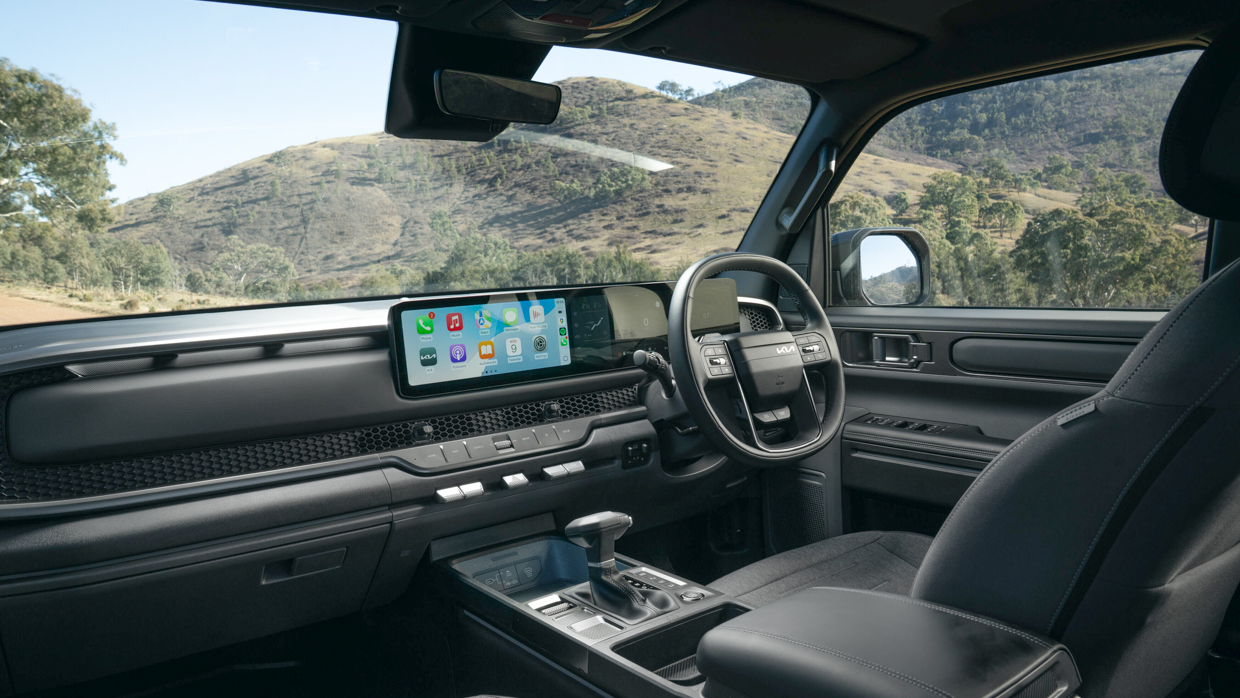
Material quality carefully walks the line between being too basic and too plush. Surfaces feel durable without being harsh while the cabin avoids shiny plastics that tend to cheapen the look of some rivals. Visual design is clean and functional but not overstyled.
Still, those used to older or agricultural utes will still be ‘wowed’ by the Tasman’s standout rangewide dual 12.3-inch displays, which include a crisp fully digital instrument cluster and a central touchscreen with wireless smartphone mirroring, USB-C power, and Kia Connect remote start, climate control, and over-the-air updates.
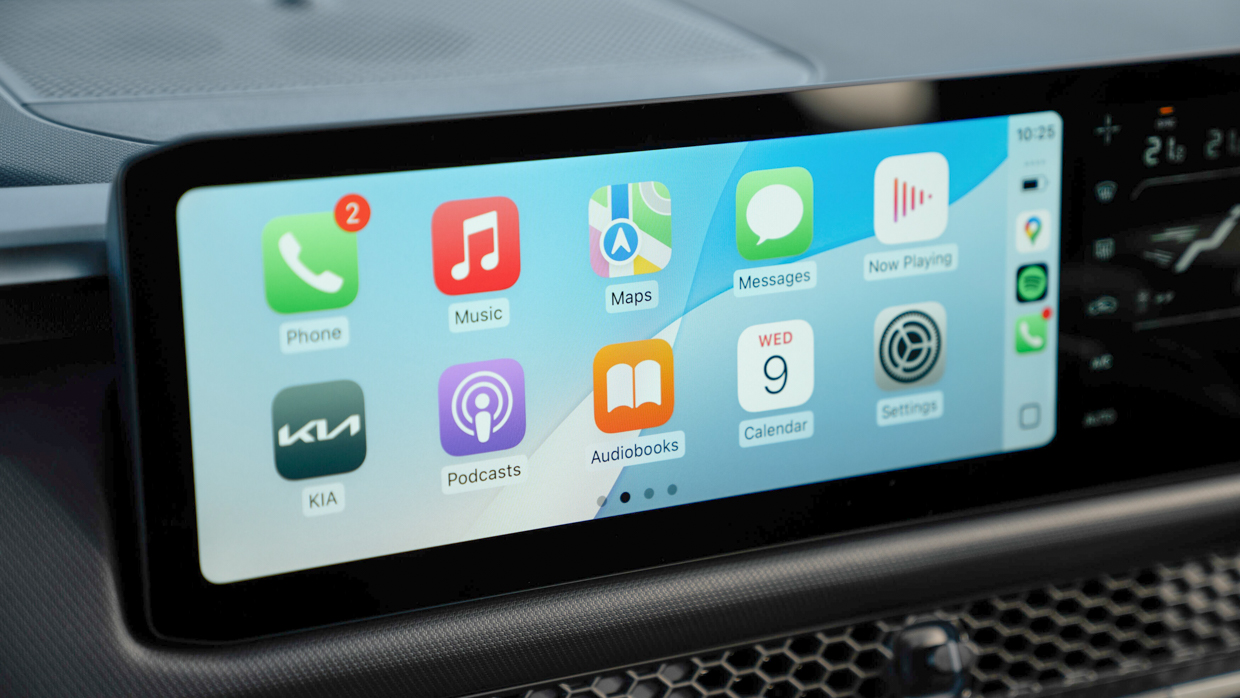

A premium-feeling trim (but not leather) covers the steering wheel and shifter (no dodgy plastic wheels here) and while seat upholstery does vary by grade, even the cloth used for S/SX feels a cut above bottom-end trim. SX+ scores nicer cloth/leatherette.
Ergonomically, the Tasman has been well-designed. Key controls are physical buttons or toggles, with easy access to fan speed, temperature and volume, while the touchscreen is also quite snappy and logical.
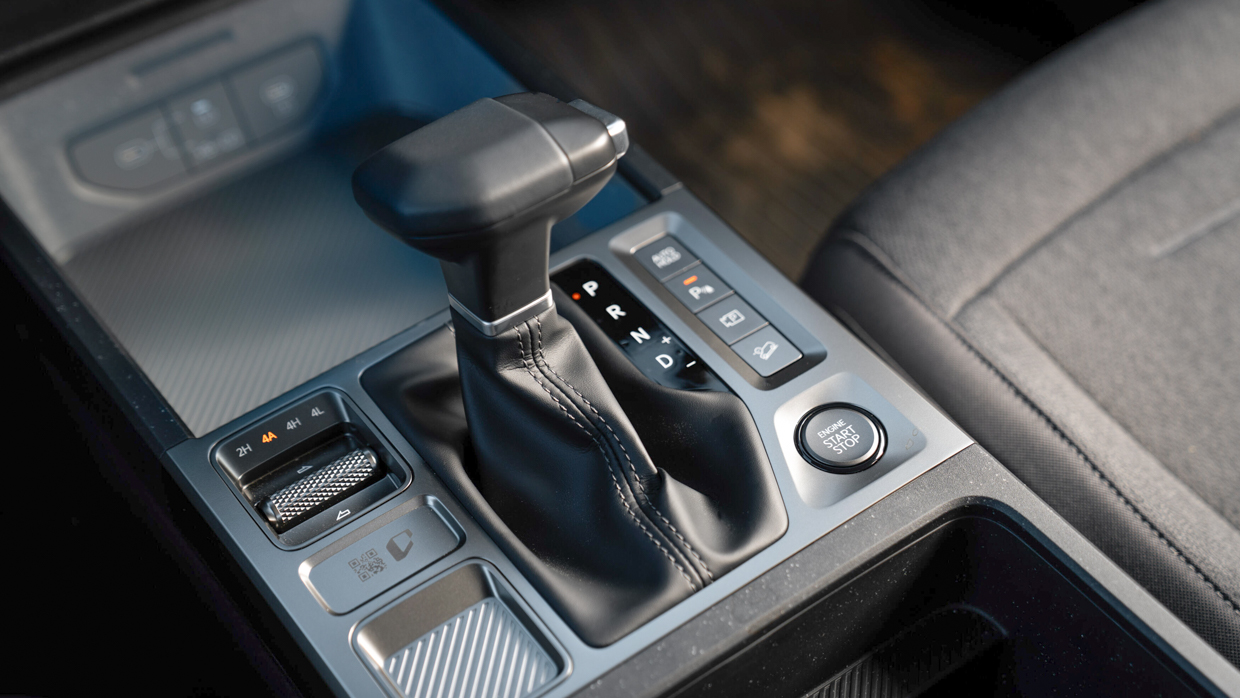
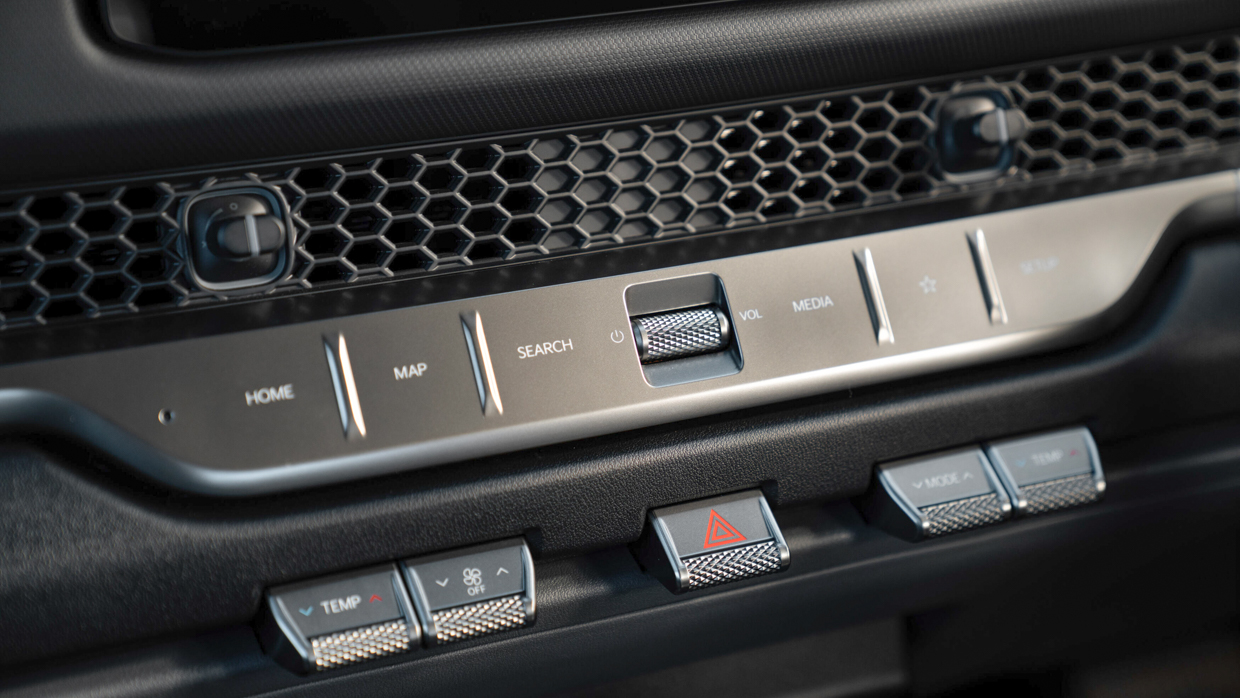
Manual seat adjustment is all you’ll find on these Tasman grades, but the shape of the seat seems to work well for most body types.
That said, the upspend on the SX+ is rewarded with expected features for 2025 including wireless charging, but also rear air vents which are a disappointing miss on the S and SX.
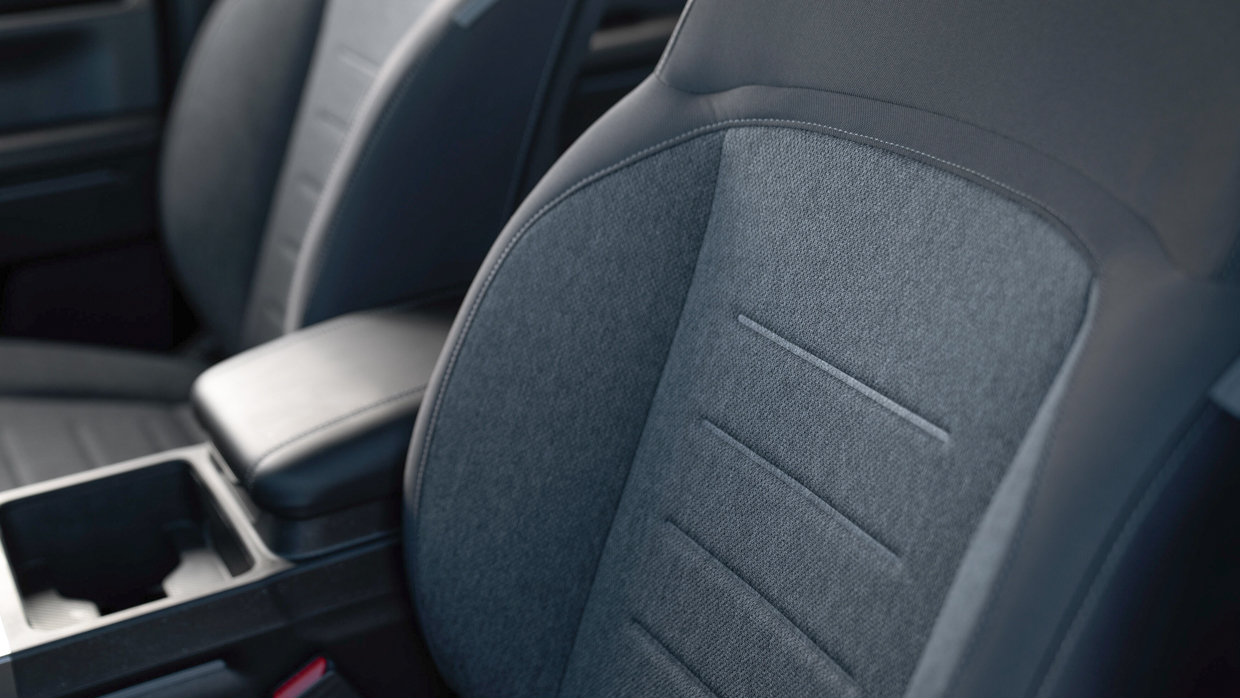

All Tasman variants have a bench-type rear seat, and three seatbelts. While the fancier X-series models add rear-seat slide and recline, the S/SX/SX+ have a fixed backrest and more legroom than most because the Kia is a longer vehicle than many rivals.
Storage space is a highlight with ample room in the cab with big cupholders and door bins, while under-seat boxes beneath the flip-up rear pews are handy for tools or keeping valuables out of sight. X-Line and X-Pro do add a handy table-style centre armrest, though.
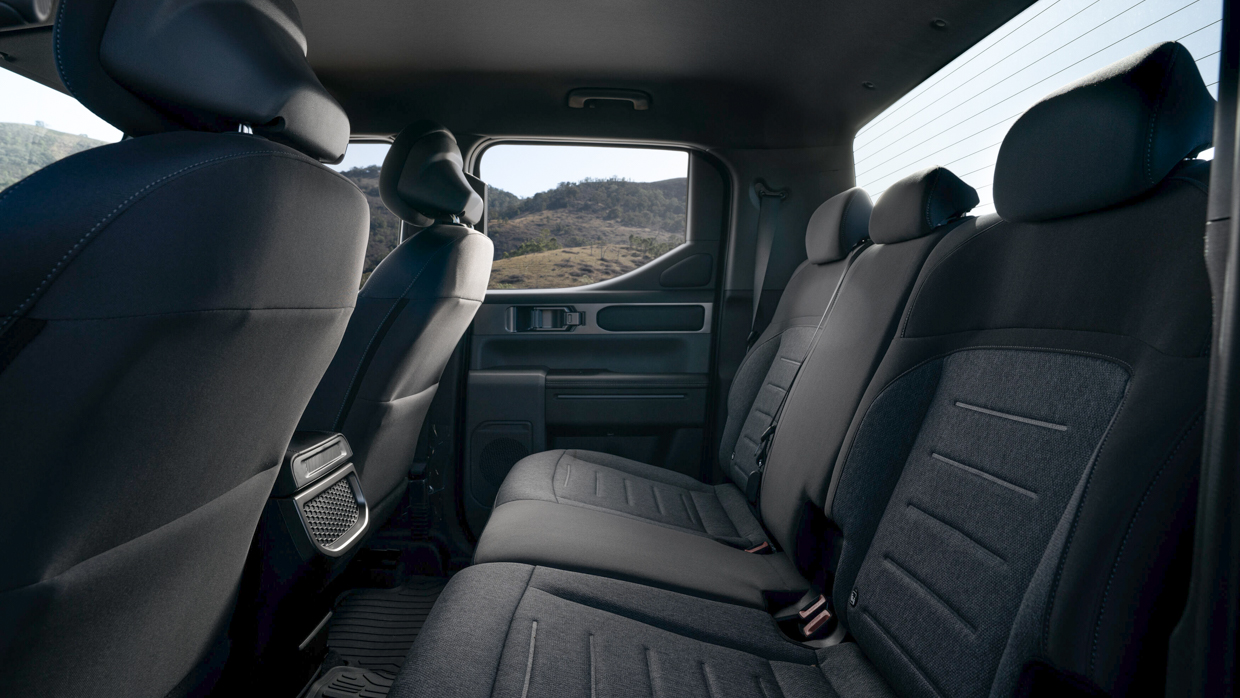
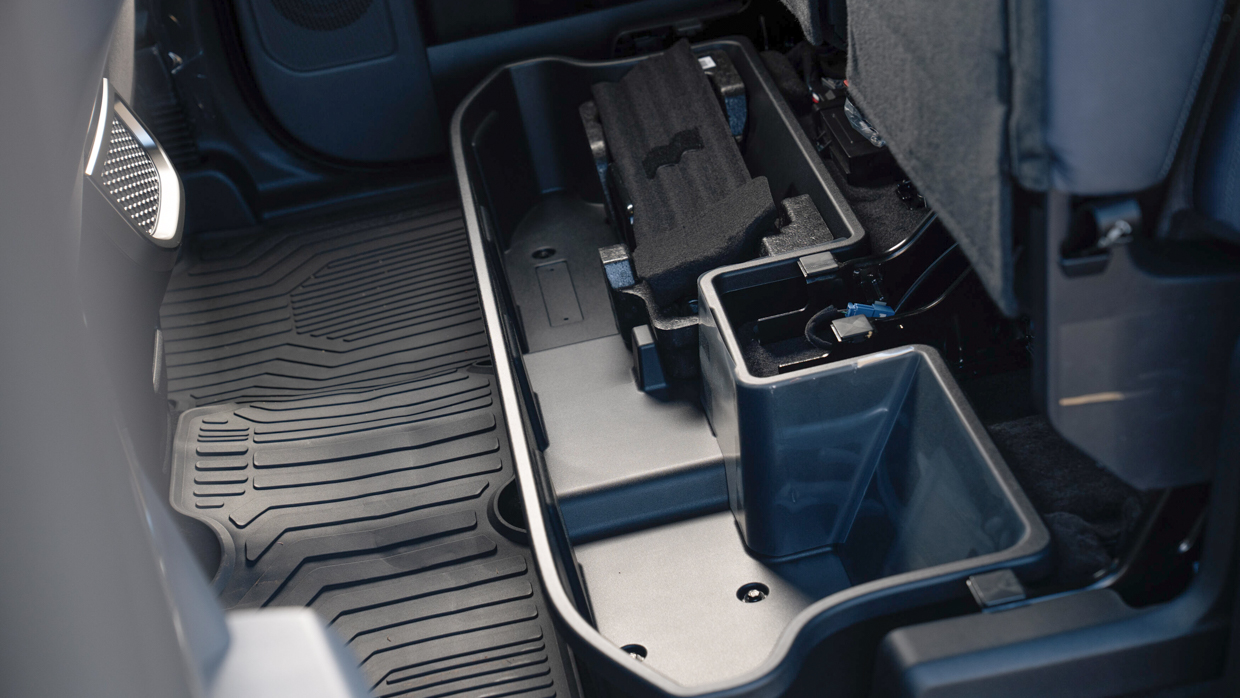
A range of dealer-installed trays are available from the 40-plus warranted accessories developed between Kia and various Australian partners in the development of the Tasman, while double cab models fit an Australian pallet in their tub and feature handy corner steps.
While most big-name utes on the market carry a five-star ANCAP safety rating, a quirk of the system is that ANCAP protocols get harder over time.
Essentially, a newer five-star rating means a vehicle has passed tougher tests than an older one.
The Tasman was subjected to the 2025 protocol which includes stricter pedestrian protection standards than before, which meant Kia was incentivised get ‘creative’.
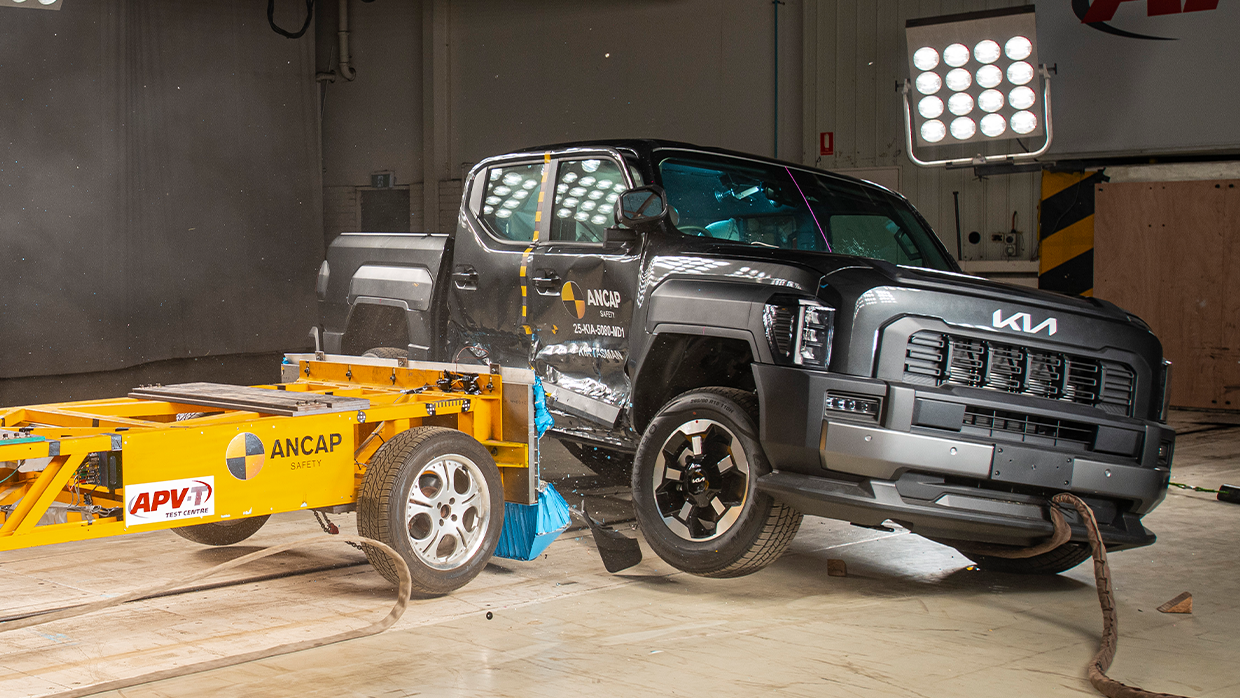
Given fleets typically require five stars, the Tasman range was split into variants that would be rated and those that would be unrated.
Compliance is by way of a low-slung front scoop design fitted to the S, SX and SX+ though nothing in the rules stops operators from buying the five-star rated variants and changing their front bar to improve clearance.
As a result, the Tasman S/SX/SX+ carry a five-star ANCAP safety rating stamped to the 2025 protocol and the X-Line and X-Pro do not.
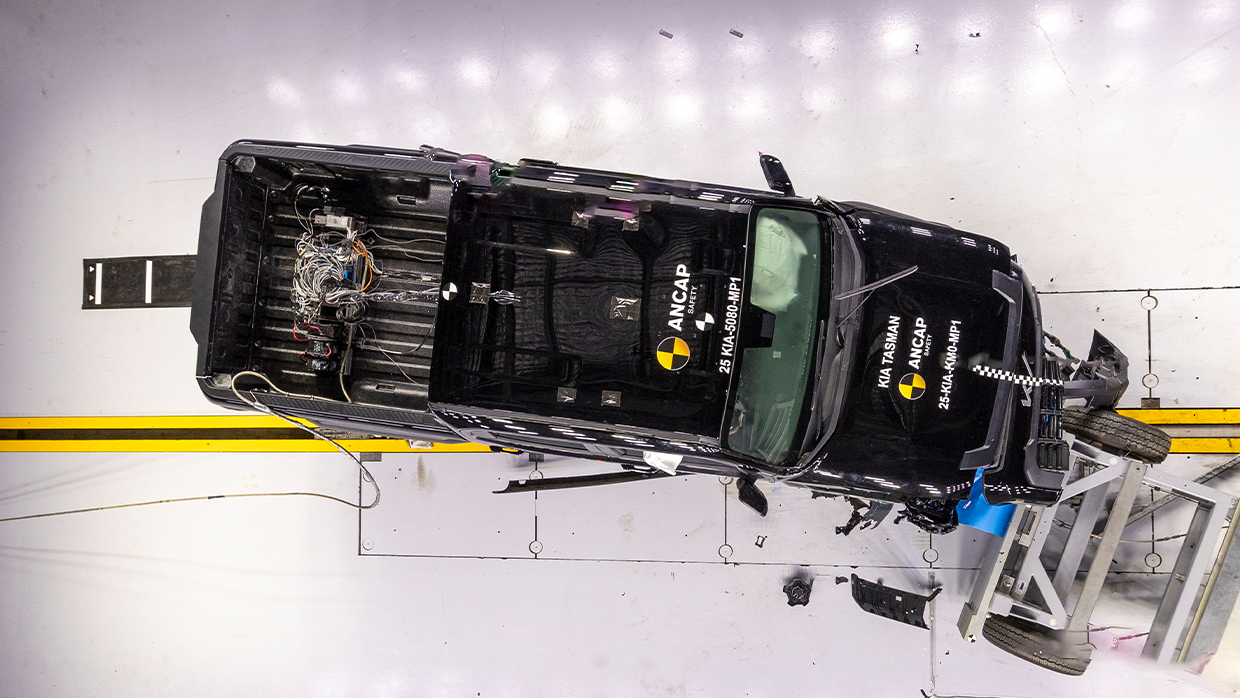
All three fleet-focussed Tasman grades come standard with an adaptive safety suite that includes:
Dual-cab models add a reversing camera as standard while SX variants pick up Kia’s Highway Driving Assist 2 (HDA2) which combines cruise control with active lane centring—useful for longer-distance stints.
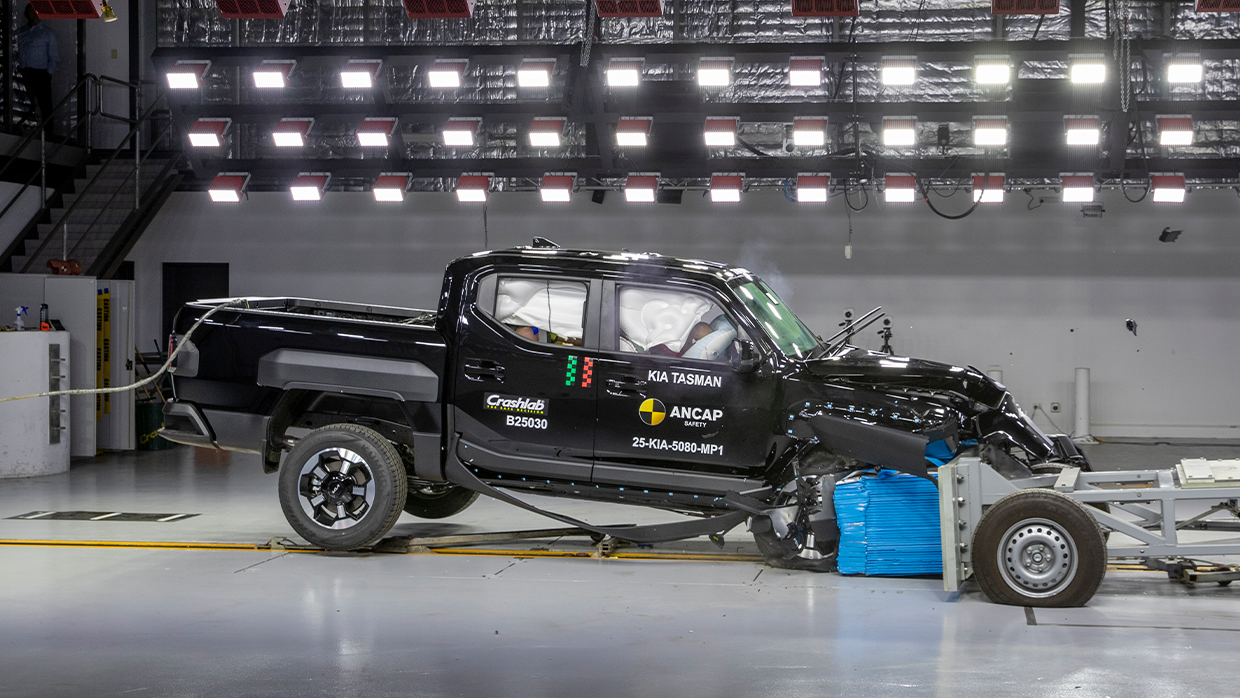
It is worth noting that reversing AEB, a 360-degree camera, and blind spot cameras, are reserved for the X-Line trim and above.
Annoyances with the Tasman’s safety systems are relatively few, though the driver attention and speed warning alerts reset on every ignition and must be turned off each time.
At least the speed bings/bongs can be deactivated easily with a long press of the ‘mute’ button on the steering wheel.
The Tasman’s 2.2-litre diesel engine doesn’t lead the ute class when it comes to power and it is also middling in terms of fuel economy.
Combined cycle fuel economy ratings are 7.4L/100km for the SX 4×2, and 7.6L/100km for the S 4×4 through to the SX+.
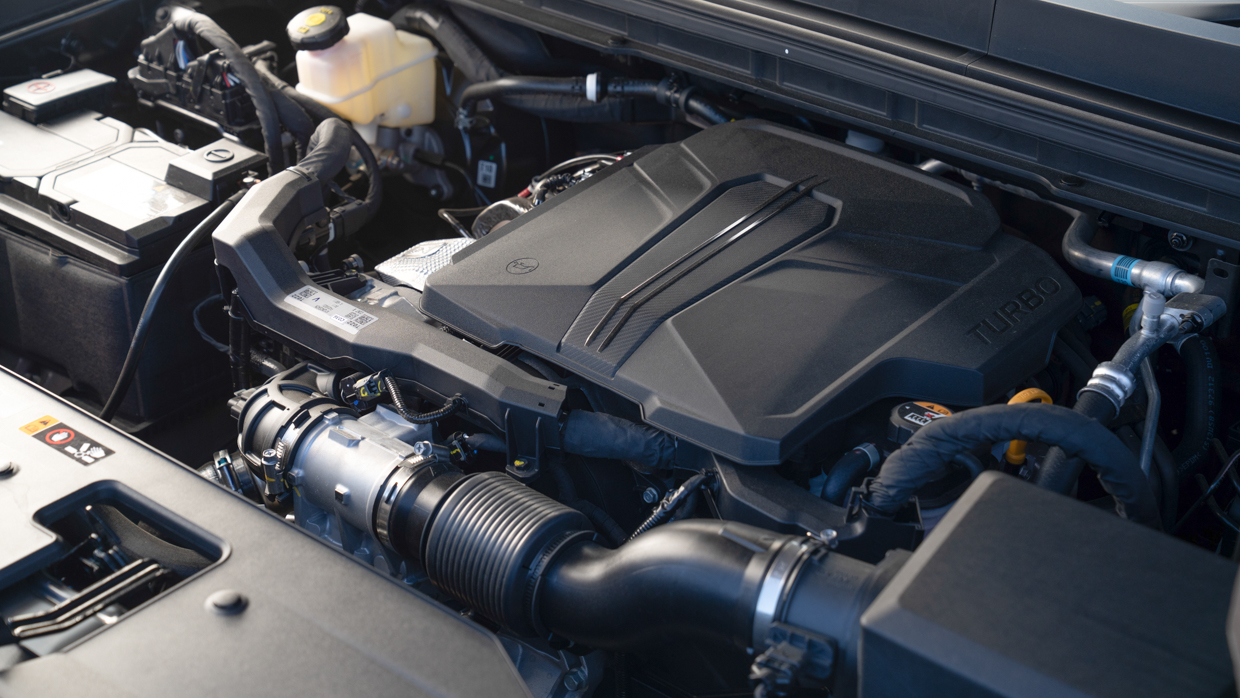
On test, we achieved 8.2L/100km in a Tasman SX dual-cab over a blend of regional, freeway, and urban driving in New South Wales.
That result is seven percent above Kia’s claim, suggesting the real-world figures are achievable with modest driving.
From its 80-litre diesel tank, the SX we tested would have delivered a range to empty of about 975km, offering good touring flexibility without frequent refuelling. A diesel particulate filter is fitted but AdBlue is not required, simplifying ongoing maintenance.
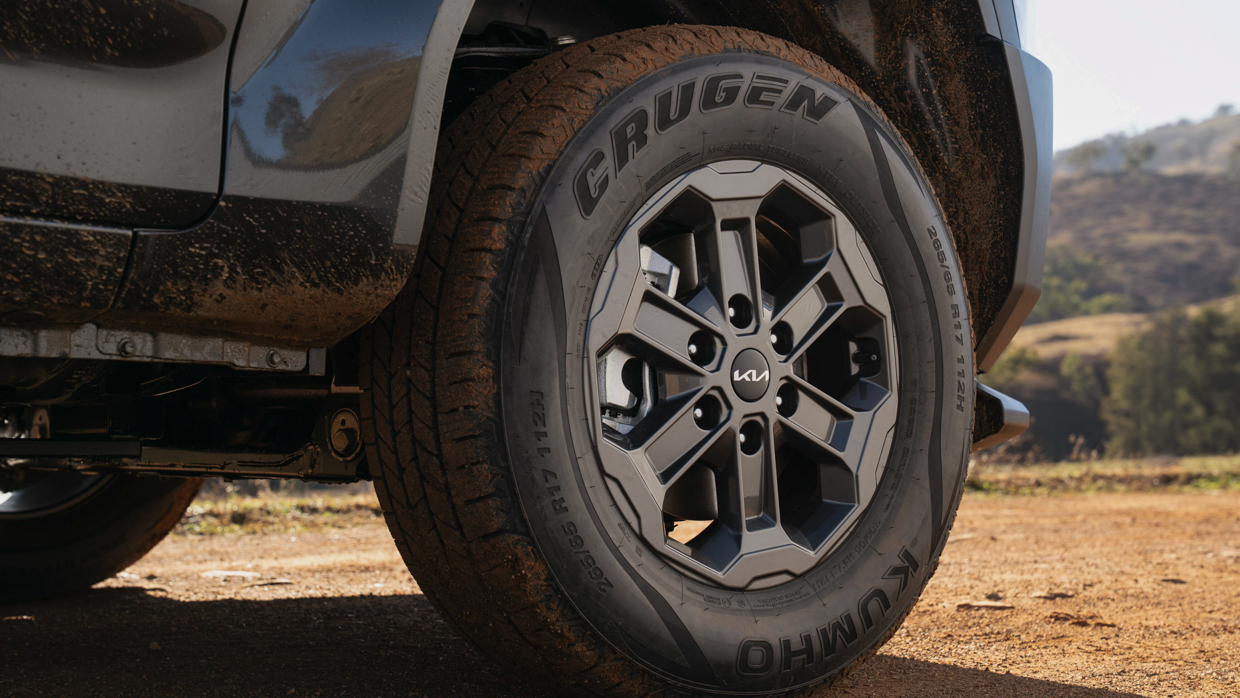
For a fleet vehicle covering 30,000km annually, using our tested consumption of 8.2L/100km at $2.00 per litre of diesel, annual diesel costs would be $4920. That’s certainly less than a Ranger or Amarok V6 and effectively lineball with most four-cylinder rivals.
Meanwhile, emerging plug-in hybrid (PHEV) utes like the BYD Shark 6 promise lower fuel use but this typically only pans out with regular charging of their batteries, with 8-12L/100km petrol consumption observed with an exhausted battery.
That said, PHEV utes will be an increasing fixture of the market in Australia due to their lower official CO2 emissions, and Kia is looking into a hybrid Tasman for the future.
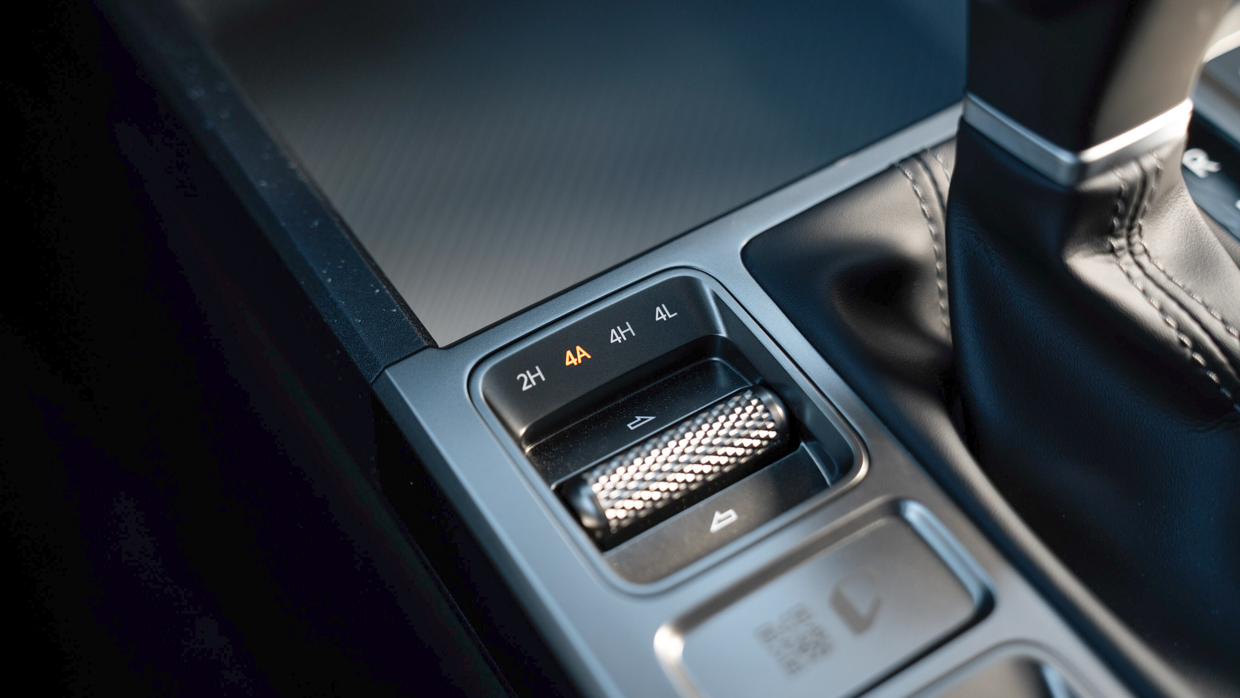
The Tasman follows annual, or 15,000km, service intervals — whichever comes first — while the manufacturer’s seven-year/unlimited-kilometre warranty applying even for government and general fleet use.
In some ways, the tradie- and fleet-focused S/SX/SX+ trims of the Kia Tasman represent the best of this new ute.
Buyers of the pricey X-Line and X-Pro grades might rightfully rue the lack of a V6 or powerful hybrid engine because they’re paying between $70,000 and $80,000 for their rig.
The more affordable lower-end versions use the same 2.2-litre four-cylinder diesel that is more acceptable when you aren’t shelling out luxe-tier cash, as the four-pot is adequately powerful and reasonably economical.
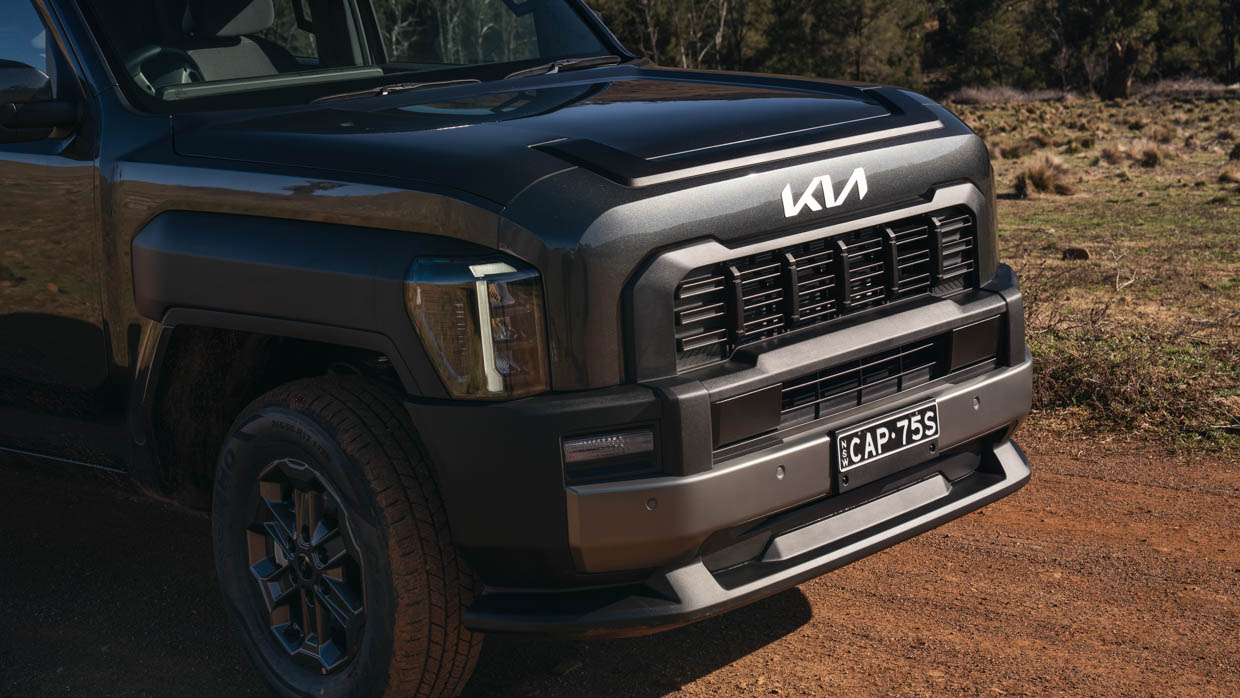
More importantly, all Tasmans benefit from careful ride and handling development, resulting in better driving dynamics than most rivals.
Then there’s the interior, which is modern, comfortable and laden with easy-to-use and well-integrated technology.
All of those factors make the Tasman easy to live with — often moreso than dated rivals.

For operators looking to tow frequently, or do lots of long-distance high-speed driving, we’d still investigate a Ranger or Amarok V6 for their additional grunt.
And for fleets with charging facilities, PHEV ute options create an interesting alternative, albeit normally with payload compromises.
Key specs (as tested)
About Chasing cars
Chasing Cars reviews are 100% independent.
Because we are powered by Budget Direct Insurance, we don’t receive advertising or sales revenue from car manufacturers.
We’re truly independent – giving you Australia’s best car reviews.
The estimate provided does not take into account your personal circumstances but is intended to give a general indication of the cost of insurance, in order to obtain a complete quote, please visit www.budgetdirect.com.au. Estimate includes 15%^ online discount.
^Conditions Apply
Budget Direct Insurance arranged by Auto & General Services Pty Ltd ACN 003 617 909(AGS) AFSL 241 411, for and on behalf of the insurer, Auto & General Insurance Company Limited(ABN 42 111 586 353, AFSL 285 571).Because we don’t know your financial needs, we can’t advise you if this insurance will suit you. You should consider your needs and the Product Disclosure Statement before making a decision to buy insurance. Terms and conditions apply.
Indicative quote based on assumptions including postcode , 40 year old male with no offences, licence suspensions or claims in the last 5 years, a NCD Rating 1 and no younger drivers listed. White car, driven up to 10,000kms a year, unfinanced, with no modifications, factory options and/or non-standard accessories, private use only and garaged at night.
^Online Discounts Terms & Conditions
1. Discounts apply to the premium paid for a new Budget Direct Gold Comprehensive Car Insurance, Third Party Property Only or Third Party Property, Fire & Theft Insurance policy initiated online on or after 29 March 2017. Discounts do not apply to optional Roadside Assistance.
2. Discounts do not apply to any renewal offer of insurance.
3. Discounts only apply to the insurance portion of the premium. Discounts are applied before government charges, taxes, levies and fees, including instalment processing fees (as applicable). The full extent of discounts may therefore be impacted.
4. We reserve the right to change the offer without notice.
